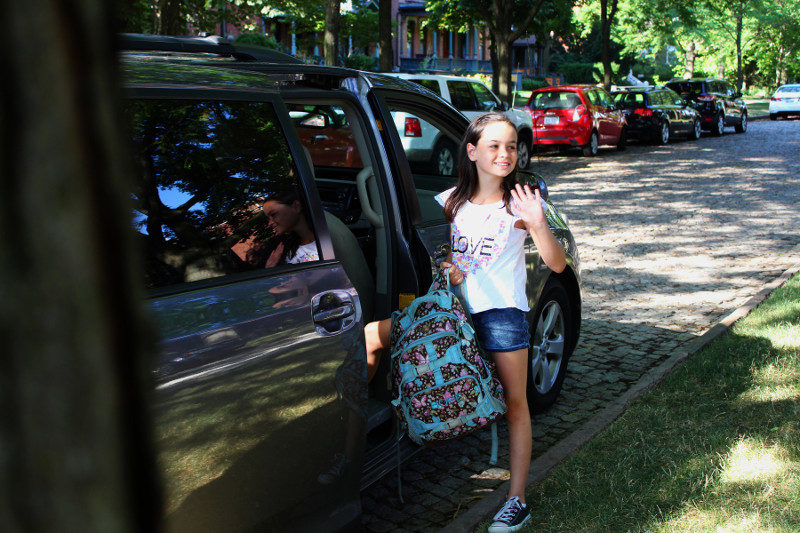
This post was originally featured on Moms Clean Air Force on August 21, 2017.
Air pollution is probably the last thing on your mind when you’re getting your kids ready for school. But how kids get to school can have a major impact on the air they breathe. Between idling buses and cars and the sheer volume of vehicles ferrying students back and forth, exhaust fumes can really mount. Kids and parents both get stuck in parking lots with no recourse but to breathe dirty air.
Here are four healthier ways to get your kids to school that will keep the air cleaner and save you time and stress to boot:
Carpool
If you put three additional kids in your car, and each of their parents drives one day a week, it reduces the number of cars driving to school by three every day. That means less congestion, less waiting time, and a lot less carbon dioxide getting pumped into the atmosphere since every gallon of gas burned generates about a pound of climate-changing CO2.
There are social benefits, too, because carpooling makes sure your kids don’t arrive or leave by themselves.
Carpooling will also save you money on gas since you’ll be driving as much as 75% less. And it will save you time. You could gain 8 hours a week by carpooling with three other families.
Try the GoKid mobile app.
Stefanie Lemcke, a mother of two tweens, hated getting trapped in traffic jams with her neighbors as they all drove to the same place at the same time to drop off and pick up their kids. She created GoKid, a mobile app that makes it easy to set up and manage carpools for all kinds of school-related activities.
It includes GPS-based tracking of cars, live mapping functionality, in-app texting, and automatic alerts.
Take the Bus
School buses are actually the largest form of mass transit in the United States, reports the American School Bus Council.
There are lots of benefits to this arrangement.
Every school bus on the road eliminates approximately 36 cars.
In 2010, school buses saved the United States 2.3 billion gallons of gasoline, representing $6 billion in savings at 2010 fuel prices.
School buses save parents time, too. Even if you walk your child to the bus stop and wait until she gets on, you’ll probably spend less time than if you were driving to school, waiting in the drop-off line, and driving home.
Some kids may not take the bus that’s available in their school district because they’re too disorganized in the morning and miss it.
Wake your kids up early enough so they have enough time to get ready. The night before, have them pack their lunches, figure out what they’re going to wear, and put their backpacks, musical instruments, sports gear, and anything else they need near the door and ready to go. Give them a 5-minute warning before they absolutely must leave the house and head to the bus stop.
Bike to School
Plenty of parents in my neighborhood have adapted bicycles built for two so they can safely pedal smaller kids to school in the morning. Whether your kids are biking solo, with their friends, or with you, they should all wear a properly fitting bike helmet, maybe one they pick out themselves, which they’ll be more likely to wear. Arrange a ride pool so kids won’t ride alone. Map out the safest route to school they can take. Also, make sure they’ve got front and rear lights so they’ll be more visible to motorists. An easy-to-reach bell will alert pedestrians and other cyclists that your child is coming along. And of course, make sure your child can use her brakes at a moment’s notice.
Walk to School
In many communities, kids who live within a mile radius are expected to walk to school. If that’s the case in your neighborhood, set up walking groups rather than drive your child individually. We had our kids walking to school in all kinds of weather so they wouldn’t be afraid of the elements. Of course, their safety is of preeminent concern, and I personally didn’t send my own little kids out the door to walk the four blocks to school if they were alone. I walked with them as long as they’d let me, appreciating the chance to get a little exercise in the morning as well as deliver them safely to their destination.
NOTE: Stop the school bus idling.
As good as buses are for moving a lot of kids at one time, they can really foul the air if they idle. The idling problem is particularly bad when buses are waiting to pick kids up at the end of the day.
That’s why EPA has set up a website to promote “idle free schools.” Says EPA, “When they are exposed to elevated levels of these (engine) pollutants, children have an increased risk of developing asthma, respiratory problems, and other adverse health effects. Limiting a vehicle’s idling time can dramatically reduce these pollutants and children’s exposure to them.”


